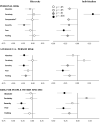Worldview Orientations and Personal and Social Risk Perceptions for COVID-19 in a U.S. Population-Based Sample
- PMID: 36394703
- PMCID: PMC9670042
- DOI: 10.1007/s10935-022-00715-x
Worldview Orientations and Personal and Social Risk Perceptions for COVID-19 in a U.S. Population-Based Sample
Abstract
Adoption of COVID-19 preventive behaviors involves considering personal risk and the risk to others. Consequently, many COVID-19 prevention measures are intended to protect both the individual engaging in the behavior and others in the population. Yet, the preponderance of research is focused on perceptions of an individual's personal risk, making risk perception for others a critical area for investigation. Two worldview orientations describing values regarding how society should be organized, hierarchy-beliefs prioritizing social hierarchy, and individualism-beliefs prioritizing personal autonomy, have been linked to a range of risk perceptions. This study objective is to examine the association of worldview orientations with COVID-19 risk perceptions for oneself and others in a United States context. Using a national sample of 410 U.S. adults, we examined the associations between worldview orientations and six facets of risk (absolute risk, risk certainty, comparative risk, risk severity, fear, feelings of risk) using demographics-adjusted multivariable regression models. We conducted separate analyses for each of the following referents: (1) personal risk, (2) risk for the average person within the United States, and (3) risk to people within specific social groups (e.g., family, co-workers). Results indicate that stronger hierarchical and individualistic orientations were associated with lower COVID-19 risk perceptions for all three referents. The results were particularly consistent for fear and feelings of risk. Individualism was related to higher risk perception certainty for personal risk and the risk to people within specific social groups. Hierarchy was related to lower perceived severity for all referents. Findings suggest that U.S. public health messaging sensitive to worldview orientations may be needed to optimize acceptance of recommendations for protective behaviors, including vaccination. The relationship of worldview orientations to health risk perceptions may help guide messaging for future infectious outbreaks where risk perceptions are t drivers of protective behavior.
Keywords: COVID-19; Hierarchy; Individualism; Risk perception; Worldview orientations.
© 2022. The Author(s), under exclusive licence to Springer Science+Business Media, LLC, part of Springer Nature.
Conflict of interest statement
None of the authors have conflicts of interest or competing interests that would influence reporting of study results.
Figures

Similar articles
-
Cultural Worldviews and Perceived Risk of Colon Cancer and Diabetes.Health Risk Soc. 2020;22(5-6):324-345. doi: 10.1080/13698575.2020.1827142. Epub 2020 Sep 29. Health Risk Soc. 2020. PMID: 33762881 Free PMC article.
-
Risk perceptions and COVID-19 protective behaviors: A two-wave longitudinal study of epidemic and post-epidemic periods.Soc Sci Med. 2022 May;301:114949. doi: 10.1016/j.socscimed.2022.114949. Epub 2022 Mar 26. Soc Sci Med. 2022. PMID: 35381434 Free PMC article.
-
The scientistic worldview and its relationships with fear of COVID, conspiracy beliefs, preventive behaviors, and attitudes towards vaccines during the COVID-19 pandemic in a Polish sample.Curr Issues Personal Psychol. 2022 Nov 9;11(1):11-28. doi: 10.5114/cipp.2021.111633. eCollection 2023. Curr Issues Personal Psychol. 2022. PMID: 38013829 Free PMC article.
-
Risk-Likelihood Perceptions and Preventive Behaviors Against Infectious Diseases: Testing Different Types of Risk-Likelihood Perceptions in the Context of MERS and COVID-19.Health Commun. 2023 Oct;38(10):2221-2234. doi: 10.1080/10410236.2022.2059831. Epub 2022 Apr 17. Health Commun. 2023. PMID: 35430935 Review.
-
Digital contact tracing technologies in epidemics: a rapid review.Cochrane Database Syst Rev. 2020 Aug 18;8(8):CD013699. doi: 10.1002/14651858.CD013699. Cochrane Database Syst Rev. 2020. PMID: 33502000 Free PMC article.
Cited by
-
The paradox of pandemic mitigation? Moderating role of pandemic severity on the impact of social distancing policies: a cultural value perspective.Global Health. 2024 Feb 9;20(1):13. doi: 10.1186/s12992-024-01018-y. Global Health. 2024. PMID: 38331903 Free PMC article.
References
Publication types
MeSH terms
Grants and funding
LinkOut - more resources
Full Text Sources
Medical
